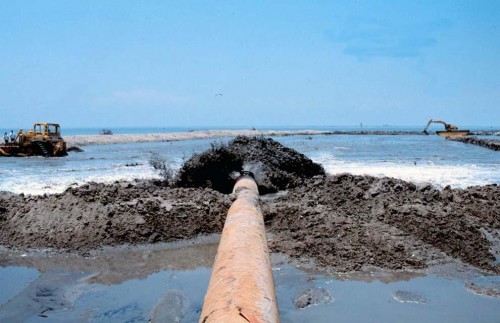
Russell Bruce
September 22, 2009
Zenobia Barrow
September 24, 2009Some experts say oil companies are partly to blame for the land lost along the Louisiana coast because they’ve dug hundreds of miles of canal to explore for oil and gas.
However, Kerry St. Pé, director of the Barataria-Terrebonne National Estuary Program, said it’s not entirely the oil and gas industries’ fault because they had permission from the federal and state governments to do the work.
The fault, according to St. Pé, resides with the state and federal agency heads appointed by past governors. The brunt of the blame does not stop there.
St. Pé asked, Who elects the governors?
“We do,” he answered. “I think we have ourselves to blame a little for the land loss. None of those canals could be dredged without a permit. And the state and federal agencies gave them the authority to do it, people we appointed and elected to make the decision for us.”
St. Pé said many big oil and gas companies are concerned about the restoration of the coast. The America’s WETLANDS campaign continuously receives state and federal monies, as well as funds from oil and gas companies for various projects.
“Just as we are losing the coastline, their pipelines are being exposed,” St. Pé said. “Their pipelines are exposed from being hit by anchors and boats to cause spills. In my opinion they have a direct benefit from seeing restored wetlands.”
Statistics from the U.S. Geological Survey show that 2,300 square miles of land have been lost since the levees were built along the Mississippi River. That amounts to 20 to 40 miles of land a year, said Chris Macaluso with the state’s Office of Coastal Protection and Restoration.
“That’s down from 40 plus square miles of land lost back in the 1970s,” he said.
The last four years of storms have also been a prime factor in land loss, Macaluso said.
According to the USGS statistics, 2005 (hurricanes Katrina and Rita) coupled with 2008 (hurricanes Gustav and Ike) washed away 340 square miles of coastland.
Local coastal restoration advocates and the big oil and gas contributors first joined forces in 1997 on a spill prevention project, according to St. Pé. The project demonstrated the benefits of preventing oil spills rather than spending tons of money cleaning up the spills.
“It was more economically feasible and sensible to spend the money preventing the spills,” he explained. “At the time we used data from a small independent oil company called Danbury Management. We built some precedents. Ed (Landgraf) contacted BTNEP to offer up Shell’s oil spill prevention program that followed the same premises. Ed brought data to our program and we used that data to develop a sound oil spill prevention program.”
Ed Landgraf is the regional coordinator for Shell Pipeline Company. “I have made a personal commitment to helping the industry understand the importance they have and their significance,” he said.
Landgraf is also the oil and gas representative for the Terrebonne Parish Coastal Zone Management Program.
According to him, it is important for oil and gas companies to help restore the coast.
“A lot of people do not understand that oil and gas companies are imperative because of the myriad of infrastructure, support and employee base in this region, which contributes to our national energy and economic security,” he said. “Energy and related companies all work together in the region to make this area what it is. We are energy friendly, but we are also environmentally responsible.”
The major benefits for oil and gas companies to have the coast restored are simple, Landgraf said.
“First, it’s the people – the employees – that we need to sustain our industry,” he said. “With them we protect our culture. The very people we have working for us are the same people who grew up in this area, who have a vested interest in keeping the Cajun culture alive.
“The second reason would be the infrastructure that is protected by the coast. The area has several refineries located along the coast, and it doesn’t matter that they are vulnerable to the hurricanes and storm surges because they prefer to be closer to the source. So we have to protect them as best as possible.”
Over the past 10 years, Landgraf said he seen more oil and gas companies get involved in many different ways.
In recent years, St. Pé said the quickest way to restore the land lost to the Gulf of Mexico is by dredging and transporting sediment from the Mississippi River and other places with compatible soil and materials.
Shell, ConocoPhillips and ChevronTexaco corporation have contributed to those projects as well.
Shell and ChevronTexaco donated funds to help construct a 780-acre ridge in the wetland marsh system at Port Fourchon, St. Pé said. Others include pipeline sediment transport projects in Timbalier Bay and Bay Chaland Headland
The newest project is the Bayou Dupont project where sediment will be pumped from the Mississippi River to restore the land.
The project will stretch from Plaquemines Parish into Jefferson Parish and make its way to Lafourche Parish, according to officials with the state Office of Coastal Protection and Restoration.
The total costs of many of the projects are unknown because the price depends on the amount of land that is being restored, St. Pé said. And without some help from the oil and gas leaders, many of the projects would not move from the development stage.
“We need the help,” St. Pé said. “We have got to have the help. They have something that’s very valuable to us. They own pipeline rights-of-way for one thing. We can put support pipelines over those rights-of-way to get sediment pumped from one place to another.
“We need sediment and we will pretty much need it forever,” he added.
ConocoPhillips owns most of the wetlands in the Barataria-Terrebonne system.
BTNEP operates on a $1.2 million budget, much of which is donated by the oil and gas industry, St. Pé said. Donations fund three calendars BTNEP produces for local residents – a bird, tidal graph and oil prevention calendars.
The first is the Bird Calendar that focuses on the many birds that nest in Louisiana. “ConocoPhillips funds the printing and distribution for the calendar,” he said.
Another calendar is the highly popular Tidal Graph Calendar that shows fishermen the tides for each day. In the past, St. Pé said BTNEP has received funding from Shell Pipeline Company. This year, Exxon Pipeline Company is donating money to help support the calendar.
The last calendar is the Oil Spill Prevention Calendar. St. Pé said Shell contributes money to that calendar also.
Pipeline sediment transfer is a relatively new tool used for wetland restoration. Local oil and gas companies have partnered with coastal restoration organizations to use their land rights-of-way to transport sediment to marsh areas to restore land loss. * Photo courtesy of BTNEP











